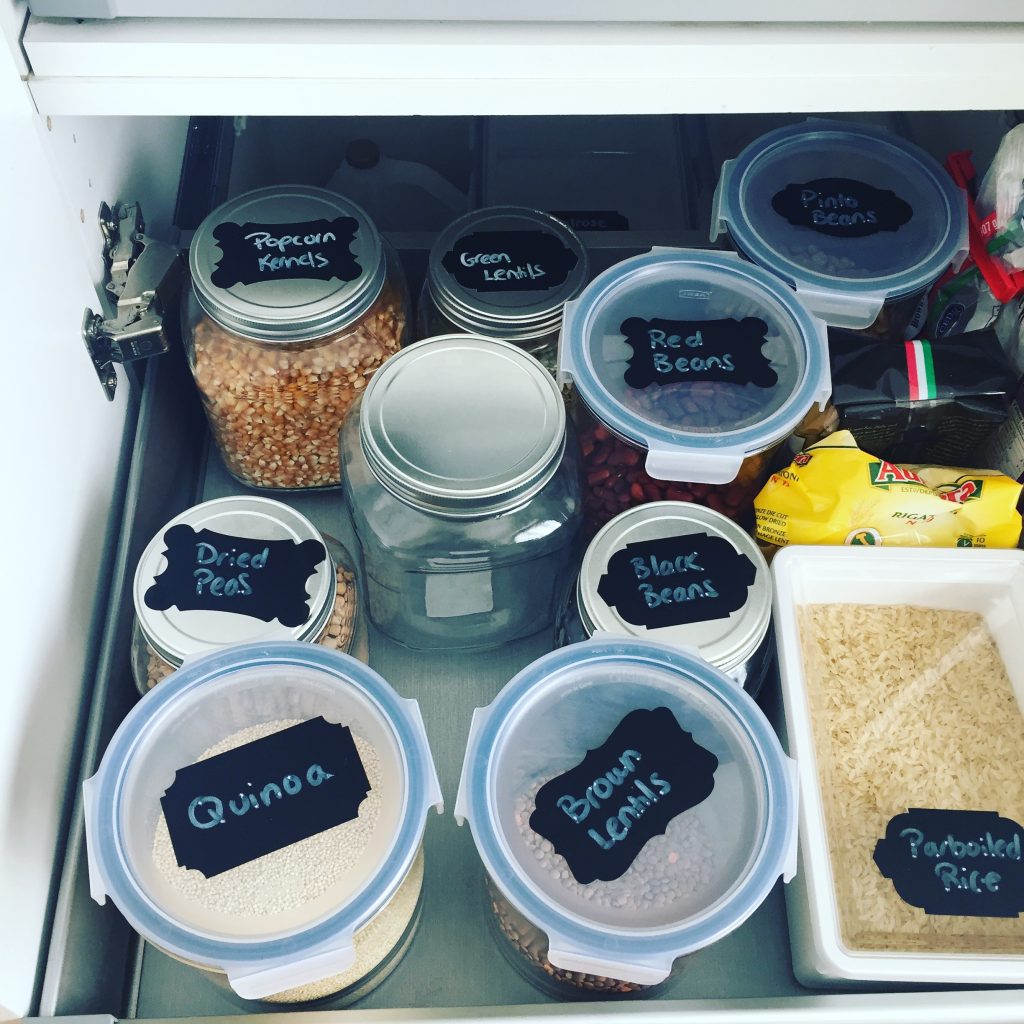
A peek into my pantry. This is the section where I store beans, grains, and pasta.
You’re probably wondering why I’m talking about pantry organizing. Aren’t we here to talk about gardening? Of course, but being a successful frugal gardener takes more than just popping some seeds into a clump of dirt. I approach gardening much like I do my health. A holistic strategy is required for best results. Everything has an impact on my gardening, including my pantry (and fridge) organization. If everything is in disorder and I don’t know where essential ingredients are, it becomes difficult to make use of what I’m harvesting in the garden. If my pantry is a mess, I don’t know what I need to replace, which may potentially lead to unwanted spending at the grocery store.
Get it Done Now
I usually only do one big cleanup of my pantry each year. I don’t have the time to do a whole bunch of mini cleanups. I also typically do it in the winter time. Why? Because it gets things ready for the spring when all my energy is focused on prepping the garden. It’s one less thing to think about.
Tips for Organizing
Whether you have a tiny cupboard or a walk-in pantry for all your dry goods, you can organize things in a way that makes sense for your lifestyle. Where there’s a will, there’s a way!
- Start small. It’s tempting to try to tackle organizing things all at once, but it can be discouraging if you don’t have the budget to buy expensive food storage containers in large quantities. Start with one shelf at a time.
- Not everything needs to match. I’ve seen the photos on Pinterest. Pantries with perfectly matched containers, everything perfectly lined up. It looks great, but it’s not realistic especially if you’re on a budget.
- Label, label, label. Label the things that need to be labeled. For instance, different types of rice need to be labeled. Pasta does not (you can identify it at a glance). I bought inexpensive chalkboard labels from Amazon so that I can erase and re-label at will.
- Head to the dollar store and look for sales. As long as containers are airtight, they’re fine for food storage. I purchased most of my storage containers at IKEA during their storage sale events.
- Organize by shelf. If your pantry has multiple levels, designate each shelf for a type of food. In my pantry, I have one shelf for snacks and nuts, another is for canned goods and spices, and one for legumes, grains, and pasta. The bottom shelf includes everything else.
- Take everything out. Remove everything when you’re ready to get started on a big cleanup project. Have all the containers you need? Labels at the ready? Get everything out of there before you start organizing. You’ll be able to visualize everything a lot better.
- Disinfect. Wipe down shelves and all surfaces so everything is spic and span.
- Buy clear jars and containers. You’ll be able to see when it’s time to replenish lentils and grains with a simple glance.
- Containers over boxes. I’ve always tried to have a neat pantry. Even when I purchased boxed goods like pasta or grains, I’d find a way to store everything neatly. The problem was, it still looked overwhelming and cluttered. Containers and jars lessen the visual clutter and make opening the pantry a lot nicer than before.
- Extra containers. Get an extra jar or container, so there’s always a place to put newly purchased dry goods. Use them in rotation to store the stuff you don’t buy often.
Have any questions about pantry organization? Let me know by leaving a comment. I’m no Marie Kondo, but I sure do love when things have their place, and clutter is kept to a minimum!

Steph Coelho is a freelance writer gardening in zone 5b. She is a certified Square Foot Gardener and has taught various garden-related workshops. When she’s not digging in the dirt or writing, she’s cooking up fresh produce, running, or listening to her favorite podcasts.
Leave a Reply